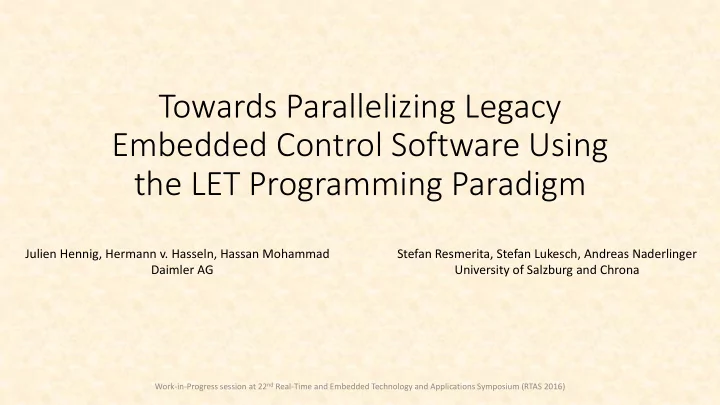

Towards Parallelizing Legacy Embedded Control Software Using the LET Programming Paradigm Julien Hennig, Hermann v. Hasseln, Hassan Mohammad Stefan Resmerita, Stefan Lukesch, Andreas Naderlinger Daimler AG University of Salzburg and Chrona Work-in-Progress session at 22 nd Real-Time and Embedded Technology and Applications Symposium (RTAS 2016)
The Challenge • evolutionary development of automotive powertrain software • increasing demand for processing power migration to multi-core • rewriting of our complete SW would be too much effort Hennig, von Hasseln, Mohammad, Resmerita, Lukesch, Naderlinger – Towards Parallelizing Legacy Embedded Control 2016-04-12 2 Software Using the LET Programming Paradigm
The Challenge • evolutionary development of automotive powertrain software • increasing demand for processing power migration to multi-core • rewriting of our complete SW would be too much effort migration of CPC-SW from single-core to multi-core • minimize changes in application source code and functional behavior • intuitive, standard-supported specification of parallel behavior • built-in robustness Hennig, von Hasseln, Mohammad, Resmerita, Lukesch, Naderlinger – Towards Parallelizing Legacy Embedded Control 2016-04-12 3 Software Using the LET Programming Paradigm
1 st Step: Parallelization • based on analysis of data dependencies between runnables • forward dependencies are to be preserved • some backward dependencies may change to forward R1 R1 R2 R2 R3 R3 R4 R4 R8 R5 R7 R6 R9 R7 R5 R8 R6 R9 Hennig, von Hasseln, Mohammad, Resmerita, Lukesch, Naderlinger – Towards Parallelizing Legacy Embedded Control 2016-04-12 4 Software Using the LET Programming Paradigm
2 nd Step: LET-based Implementation with TDL • Logical Execution Time (LET) paradigm for synchronization • specification with the Timing Definition Language (TDL) R1 R2 R3 R4 R8 R7 R9 R5 R6 Hennig, von Hasseln, Mohammad, Resmerita, Lukesch, Naderlinger – Towards Parallelizing Legacy Embedded Control 2016-04-12 5 Software Using the LET Programming Paradigm
Future Work • LET integration in AUTOSAR for multi-core • first concept already developed for integration of runtime components • AUTOSAR interface development under way • we are seeking minimal extension of AUTOSAR specification • evaluation in prototypic implementation • extension to distributed functions Hennig, von Hasseln, Mohammad, Resmerita, Lukesch, Naderlinger – Towards Parallelizing Legacy Embedded Control 2016-04-12 6 Software Using the LET Programming Paradigm
R 1 R2 R 3 R 4 R1 R5 R2 R 6 R3 R 7 R 8 R4 R7 R9 R9 R8 R5 Thank you! R 6 For further information, come meet us at the poster Hennig, von Hasseln, Mohammad, Resmerita, Lukesch, Naderlinger – 2016-04-12 7 Towards Parallelizing Legacy Embedded Control Software Using the LET Programming Paradigm
Recommend
More recommend